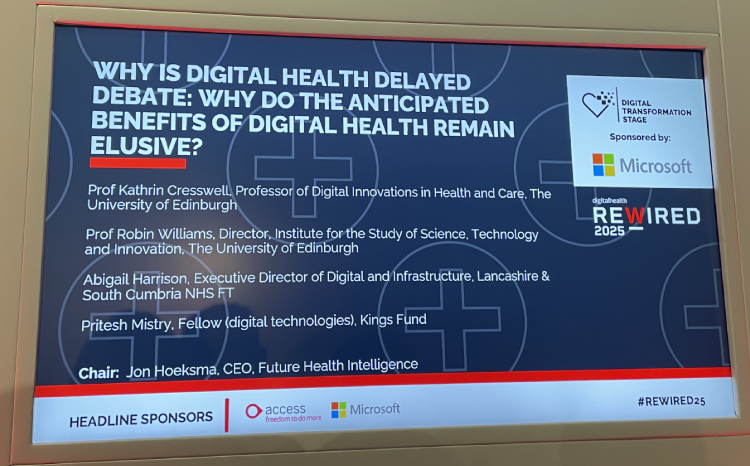Digital pathology: Do we need to take the lab out of the hospital?
- 9 March 2018

As Lord Carter’s pathology recommendations near a decade old, is it time to take the laboratory out of the hospital? Jane Rendall, managing director of Sectra UK and Ireland, asks the question.
Lord Carter made a strong case for consolidating pathology services to “improve quality, patient safety and efficiency” in his 2008 independent review of NHS pathology services in England.
Now, nearly a decade later, his case is just as valid. But despite some highly commendable pockets of consolidated services in some regions, we are still not seeing a regionalisation of reporting at the scale now needed to cope with escalating pressures on NHS resources. A virtualisation of pathology needs to happen.
Is culture the barrier?
Some of the latest findings from research giant Gartner identify culture and people as the biggest barriers to digital transformation – with healthcare by no means exempt.
Prominent health CIO Richard Corbridge, who contributed to Gartner’s research, has said the focus of his work at Leeds Teaching Hospitals will be as much about business transformation and change, as traditional IT.
Transformation for pathology goes further than digitisation – but could the obstacles preventing change be the same?
When we look at pathology, departments have remained within the hospital, often isolated from those in neighbouring hospitals, and determined to protect their reporting function. But hospitals cannot afford to be protective of their pathology assets – high tech and high cost production environments – if they are to realise and reinvest savings, ensure patients receive timely diagnoses, and widen access to increasingly scarce specialist expertise.
Regionalising these resources is the only real option, but how can we end protectionism that stands in the way? In order to consolidate and make regionalisation ideas real, transforming the reporting function may not be enough. Lifting the laboratory out of the physical location of the hospital could be the answer to removing inward thinking and resistance.
Fear and control
If you were to ask pathologists whether taking the lab out of the hospital is something they would welcome, the answer from many might very well be ‘no’.
There is a culture of control over tissue, and of control over the whole process. Quite rightly, many pathologists will want to ensure that tissue samples remain secure – after all, the thought of repeating surgery for patients will often be a near impossibility.
And completely removing the laboratory 100% from the hospital may never happen – there may always be some requirement for local processing, for adhoc requests and some urgent cases. But there are compelling reasons why we need to think differently.
The evidence shows that demand is increasing, whilst pathology resources – human, and financial – are diminishing. We need provocative thinking if we are to change for the better.
Where standard approaches are taken, there are great opportunities to shift to regionalised ways of working.
Don’t repeat mistakes seen in radiology
Pathology has an opportunity to get ahead when it comes to regionalisation, by learning lessons from colleagues in radiology.
Digital pathology is certainly an enabler and perhaps a prerequisite to regional working. But this should not be done in isolation. Why would we only look to digitise a department and miss the opportunity for economies of scale in a region?
Hospitals I talk to on a daily basis recognise the challenges of radiology systems not talking to each other across different hospitals. But by collaborating, pathology can avoid those mistakes.
The equipment hospitals buy for analysis and laboratory processes, means the NHS is currently engaged in unnecessary repetitive high-tech spending, for work that is largely a standardised set of tasks.
Similarly, software should be procured at the regional level to prevent challenges around interoperability, and to ensure that the NHS gets a better deal from suppliers.
And from a cost point of view, we can consolidate cost centres around estates. Why do this on Charing Cross Road, for example, when you can do it on a business park? At the same time hospitals can reduce the amount they spend on expensive equipment and analysing centres.
Lord Carter’s more recent report into NHS operational efficiency has highlighted significant variances in the proportional cost of pathology, and that those areas that have consolidated pathology are the most efficient.
The alternative, retaining and potentially digitising every single pathology department as it exists today, is just throwing money away.
Provocative thinking for change
Right now the NHS Cancer Vanguard is carrying out a detailed feasibility study of how digital pathology can help the NHS improve diagnoses for patients, which will build on strong evidence from overseas and early pilot programmes in the UK.
This important work will not reveal how digitisation can work in practice within NHS structures, and in the context of regionalised workflow now being driven by the creation of sustainability and transformation footprints.
The answers need to be worked out at the regional level, but we don’t need to have a complete solution from day one to act.
Hospitals and regions might be able to invest today if suppliers can be open with their solutions, and provide the flexibility that allows regions to start to tackle questions around security of tissue, around where they locate their regional pathology hub, and around what good looks like.
When they do have the answers, they need to have the underlying systems in place, ready to support their new approaches without delay.
There may be local concerns from pathologists that need to be addressed. But we have a bigger opportunity to make pathology more efficient for the patient, to focus expertise where it is needed more quickly.
Leadership must look at the bigger picture. If we don’t change because of fears, we will never change anything.
Jane Rendall is managing director of Sectra UK and Ireland.





5 Comments
Let’s look at one example of the implementation of Carter’s work, that of Frimley et al. Seven acutes forming one virtual lab. Originally projected to go live in 2016 where is it now ? How much has been spent? Why is this situation allowed to continue?
Jacques, I agree it will take leadership that is able to see beyond traditional boundaries and needs to effect real change. Such a change must be an enabler to collaboration and provide flexible delivery models able to meet demand.
Very interesting article, particularly as I’ve had unconfirmed reports that the digital diagnostics programme might be faltering. I would see a modern communications architecture for pathology ordering and reporting as something of a prerequisite for any change of delivery patterns.
Perhaps more of an obstacle is the lack of either national strategic leadership or any kind of regional system leadership to drive through the change. Without that any rationalisation will be patchy and piecemeal at best.
You can put your faith in NHS England and ACOs to provide this, but I won’t be holding my breath.
I do see your point regards turkeys and Christmas……but it is a debate worth having I believe.
In my humble opinion, if any lab test is ‘batched up’ and done once a week or once a fortnight, then they should be shipped off to a Regional Centre. There will always be a need for local ‘hot’ testing but ‘cold’ work could be done anywhere.
Near-patient testing ( eg analysers in A& E) could also be ‘managed’ or at least QA’d by local or regional lab staff but some feel this is like turkeys voting for Christmas.
Comments are closed.